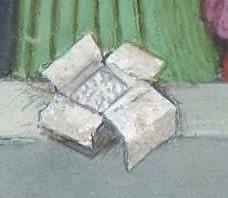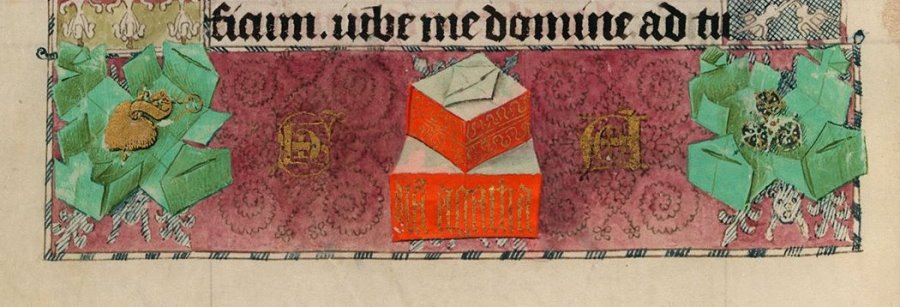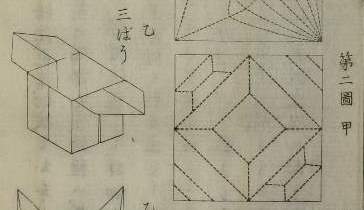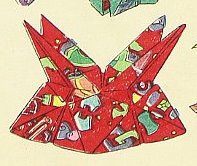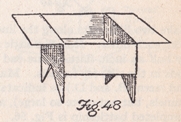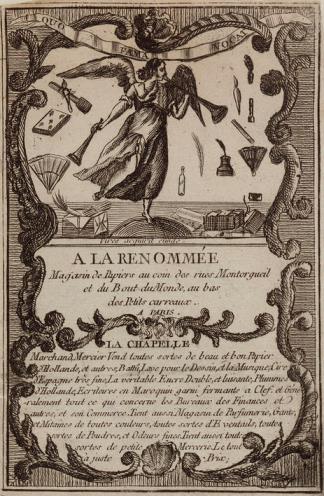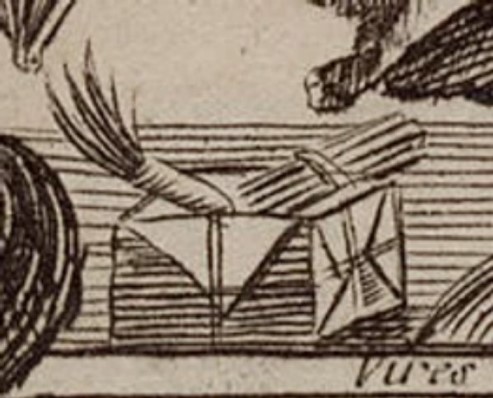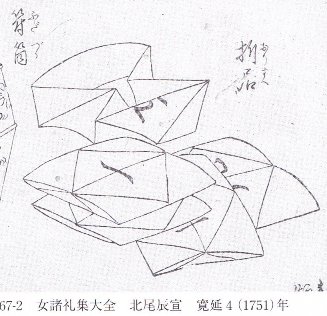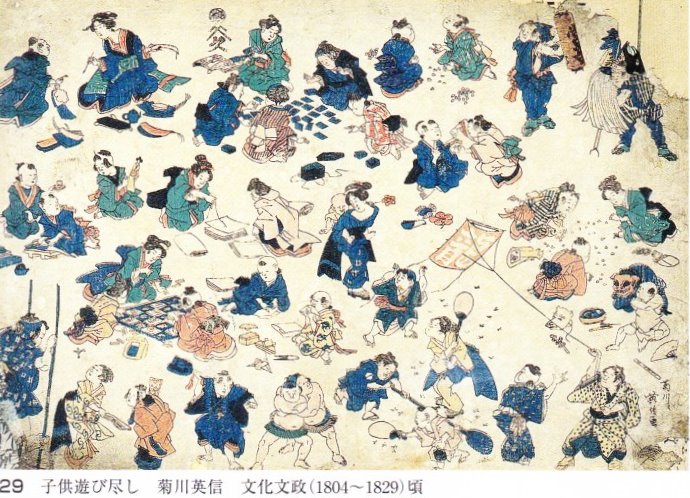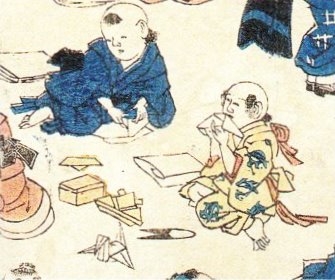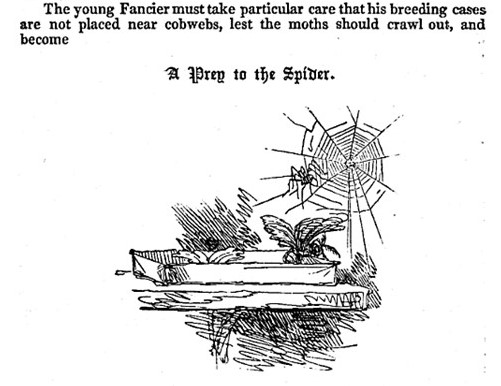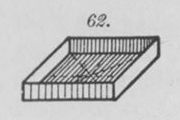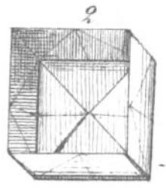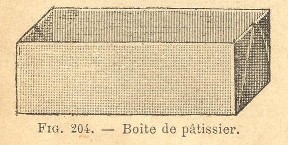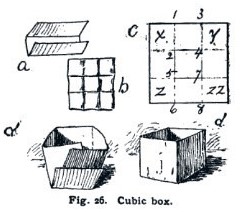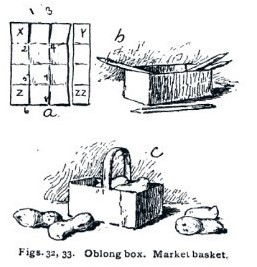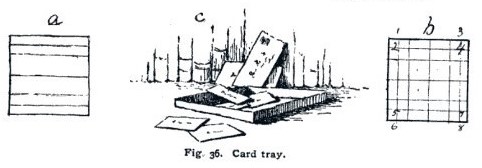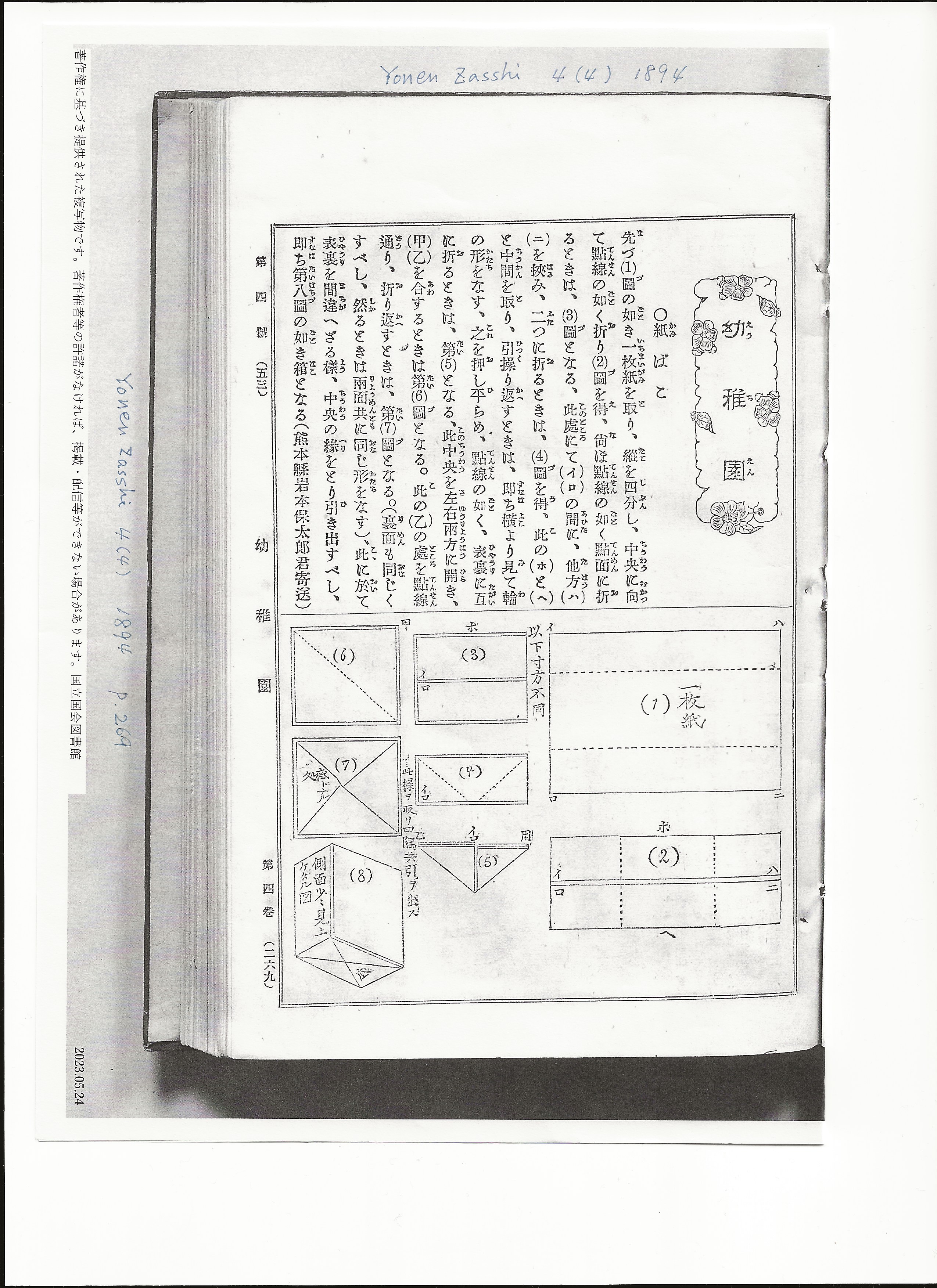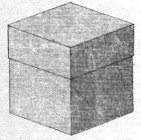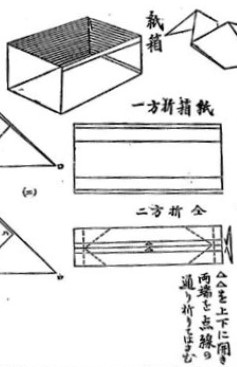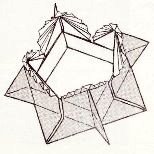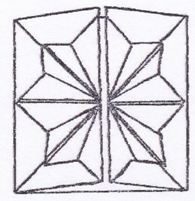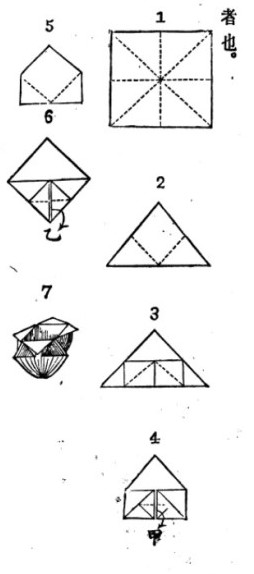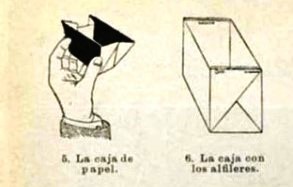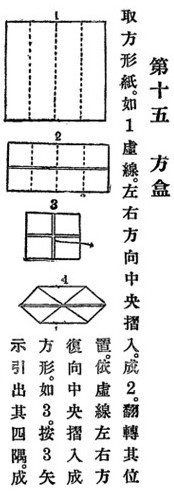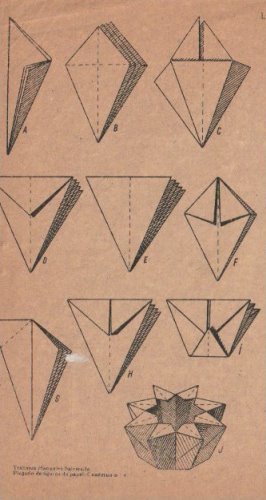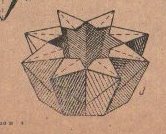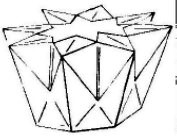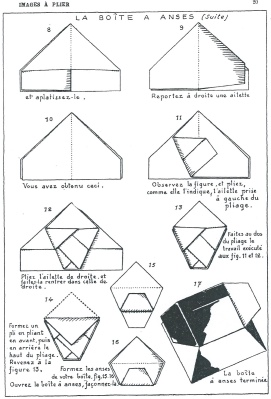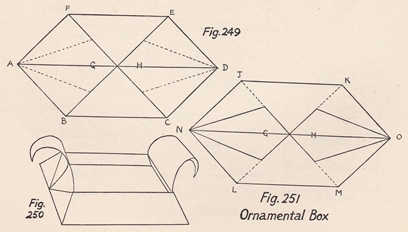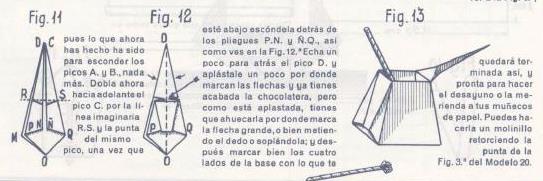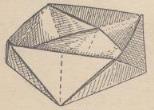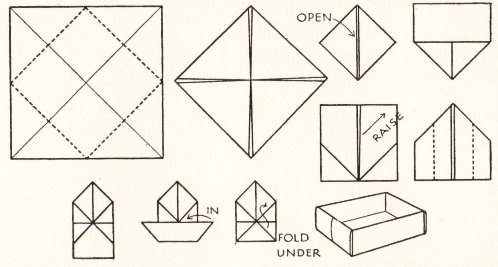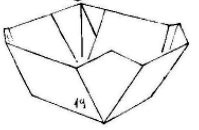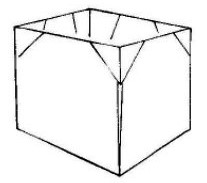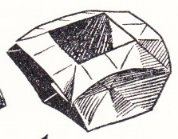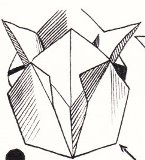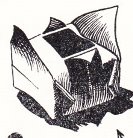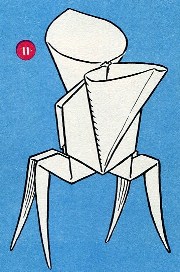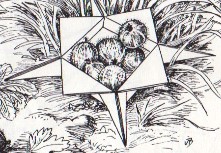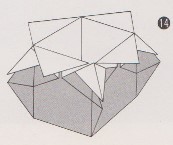| The Public Paperfolding History Project
Last updated 5/8/2025 x |
|||||||
| Boxes, Trays, Bowls and Other Containers | |||||||
| This
page is being used to collect information about the
history of folded paper Boxes, Trays, Bowls and other
containers. Please contact me if you know any of this
information is incorrect or if you have any other
information that should be added. Thank you. It is worth noting that any half-cube box can be distorted into the form shown below, which I therefore call a distorted half-cube box.
********** The Decameron Box - 1432 This box is pictured in an illustrated version of 'The Decameron' by Boccacio which can be dated to 1432.
********** The Catherine of Cleves Box - 1440 onwards
********** The Sanbo - c1720 onwards
********** The Star-Shaped Box - 1734 onwards
********** The Sanbo on Legs - 1734 onwards
********** c1730 - 1750 A box that seems to be made of folded paper appears on a trade card of La Chapelle, a Parisian merchant of luxury goods that is held in the Rothschild collection at Waddesdon Manor. (Information from Michel Grand and José Tomas Buitrago.) It can be dated, by reference to the style, to c1730 - 1750. A similar card for the tradesman Dubois is said to exist in Archives de Paris (Archives de la Seine): Publicité Commerciale à Paris: D43Z, fol. 30. The wording on the card does not mention the box. It is not clear from the engraving how the box has been folded.
********** The Collapsible Box - 1751 onwards (A version of the Basic Box made from a 3x2 rectangle)
********** There is a note in the 'Kan No Mado', usually dated to 1845, which lists a box among those designs which are already well known and which are therefore not included in the ms (in order to spare the writer's brush). Unfortunately we cannot be certain which box is being referred to here ********** 1804-1829 A print by Eishin Kikugawa (1787 - 1867) showing children playing various games includes two children, a boy and a girl, folding paper. The items threy have already folded are a Paper Crane, an unidentifiable box, a Paper Boat and what looks like a more complex version of the Kabuto or Samurai Helmet.
********** 1828 A chapter about the keeping and breeding of silkworms in 'The Boy's Own Book' by William Clarke, which was published by Vizetelly, Branston and Company in London in 1828, mentions folded paper trays made of 'fine, stout, white cartridge paper, .... doubled, into the form of a dripping pan, by turning up the edges about two inches on every side'.
An illustration at the end of the chapter shows what these trays looked like. Unfortunately the way the corners are formed is not clear from this illustration.
********** 1844 Similar trays, made for the same purpose, are mentioned in 'The Boy's Treasury of Sports, Pastimes and Recreations' by Samuel Williams, which was published by D Bogue in London in 1844.
********** The Open Box - 1859 onwards
********** The Solid Box - 1859 onwards
********** The Junk Box - 1859 onwards (A version of the Basic Box made from a doubly blintzed square)
********** The Basic Box - 1873 onwards
********** The Blintz Box or Masu - 1874 onwards
********** The Patisserie Box - 1889 onwards
********** 1890 A design for a 'Jardiniere' made from a triply blintzed square appears in 'Le travail manuel a l'ecole et dans la famille' by MM, Bertrand, Toussaint and Gombert, which was published by Loucene, Oudin et ces Editeurs in Paris in 1890.
********** 1892 'The Prang Primary Course in Art Education: Part 1: The First Primary Year' by Mary Dana Hicks and Josephine C Locke, which was published by the Prang Educational Company in Boston in 1892, contains several designs for boxes made using the slit and fold technique. Cubic Box (Cut) - From a square divided into a 3x3 grid
*** Oblong Box / Market Basket (Cut) - From a 2x3 oblong
*** Card Tray (Cut)
********** 1894 Diagrams for this complicated box - which can only be folded from very thin paper - appeared in 1894 in volume 4 issue 4 of 'Yonen Zasshi' children's magazine.
********** The Slit and Fold Cubic Box - 1897 onwards
********** The Japanese Box - 1902 onwards
********** The Incense Box - 1905 onwards
********** The Long Box - 1905 onwards
********** The Spanish Box - 1910 onwards
********** 1910 A slit and cut design for an 'Einfacher Kasten' (Simple Box), which can be turned into a basket, appears in 'Allerlei Papierarbeiten' by Hildergard Gierke and Alice Kuczynski, which was published by Drud und Verlag B G Teubner in Leipzig and Berlin in 1910.
********** The same work contains instructions for making a compound box on legs, called 'Blumentisch' (Flower Table). The box portion of the designs is a Basic Box with the ends turned inwards.
********** 1913 'Trabajo Manual' by C Champy Alvear, which was published by Cabaut y Cia in Buenos Aires in 1913, contains several designs made using the slit and fold technique.
*** p71. Caja japonesa The instructions show how to construct a lid for the box in a similar way and how to twist the two together.
********** The Bric-a-brac Box - 1914 onwards (A version of the Basic Box made from a blintzed square.) ********** The Chrysanthemum Box - 1914 onwards
********** There is a design for an 'Octagonal Box', which, despite the name, is square, in 'Zhe zhi tu shuo' (Illustrated Paperfolding), compiled by Gui Shaolie, which was published by the Commercial Press in Shanghai in Ming guo 3 (1914).
********** An article in 'Los Muchachos' of 25th October 1914 shows how to fold a simple container, described as 'una cacerola de papel' (a paper pan) and how to use it to boil water. The box is held closed by the string that is used to suspend it.
********** 1917 There is a design for a 'Square Box' in which the two triangular flaps are pasted to the sides to secure the shape, in 'Xu Zhe zhi tu shuo' (More Illustrated Paperfolding) by Yongxiang Shi, which was published by the Commercial Press in Shanghai in 1917.
********** c1929 Booklet 4 of 'Trabajos Manuales Salvatella - Plegado de figuras de papel', which was published by Editorial Miguel A Salvatera in Barcelona in or around 1929, contains diagrams for a bowl folded from a square and titled 'La Canastilla'
*** The same design appears as 'Cestito' in 'Una Hoja de Papel', which was published Miguel A Salvatella in Barcelona in 1952.
********** The Cake Box - 1931 onwards
********** 1931 A design I call the 'Inward Folded Box' appears in the revised 3rd edition of 'Lustiges Papierfaltbüchlein' by Johanna Huber, which was published by Otto Maier in Ravensburg, Germany in 1931.
********** The Box with Handles - 1932 onwards
********** The Square-Shaped Vase - 1932 onwards
********** 1935 'La Nature' Issue 2966 of 1st December 1935 contained an article by Alber headed 'Pliage de papiers' and subheaded 'Vase ou lanterne' which explains how to make a simple fold and cut box (or vase or lantern).
********** 1937 This Ornamental Box appears in 'Paper Toy Making' by Margaret Campbell, which was first published by Sir Isaac Pitman and Sons Ltd in London, probably in 1937, although both the Foreword and Preface are dated 1936, which argues that the book was complete at that date.
********** The Cut Distorted Half-Cube Box - 1939 onwards
********** 1939 La chocolatera (the Chocolate Maker) appears in 'El Mundo de Papel' by Dr Nemesio Montero, which was published by G Miranda in Edicions Infancia in Valladolid in 1939.
********** The Distorted Half-Cube Box - 1940 onwards
********** 'At Home Tonight' by Herbert McKay, which was published by Oxford University Press in London, New York and Toronto in 1940, contains diagrams for 'Dermot's Box', of which the author says 'This is, I think, the strongest and best of the boxes that can be made by paper-folding.'
********** 1951 A design for a 'Tarjetero' (Business Card Holder) appears in Plegado laminas published by Della Penna, April 1951.
********* 1952 'Una Hoja de Papel', which was published in Barcelona in 1952, contained diagrams for two paper boxes / bowls: Cesto de Fruta - From a square divided into thirds both ways - of unknown origin.
*** Maceta - From a square divided into thirds both ways - designed by Lorenzo Herrero.
********** 1956 'Paper Magic' by Robert Harbin, which was published by Oldbourne in London in 1956, contains instructions for making several containers. Harbin's Pouch.
*** Harbin's 'Vase No 1 and No 2' The text says, 'These are examples of things that can be created by just 'doodling'.
*** Tobacco Jar (attributed to Rolf Harris)
********** The 1956 Rupert Annual contains instructions for making 'Rupert's Spill Holder'. This may be an invention of Alfred Bestall.
********** 1963 A design for a 'Tray' appears in the second edition of 'Het Grote Vouwboek' by Aart van Breda, which was published by Uitgeverij van Breda in 1963.
********** The Pencil Box - 1965 onwards
********** |
|||||||

